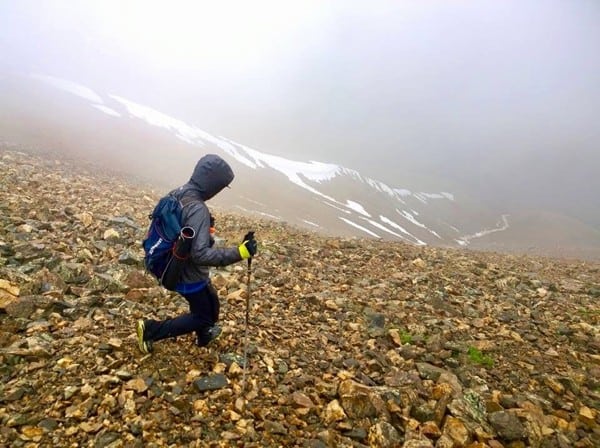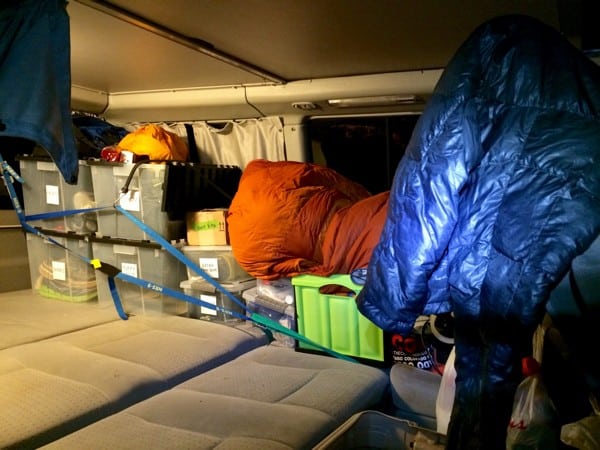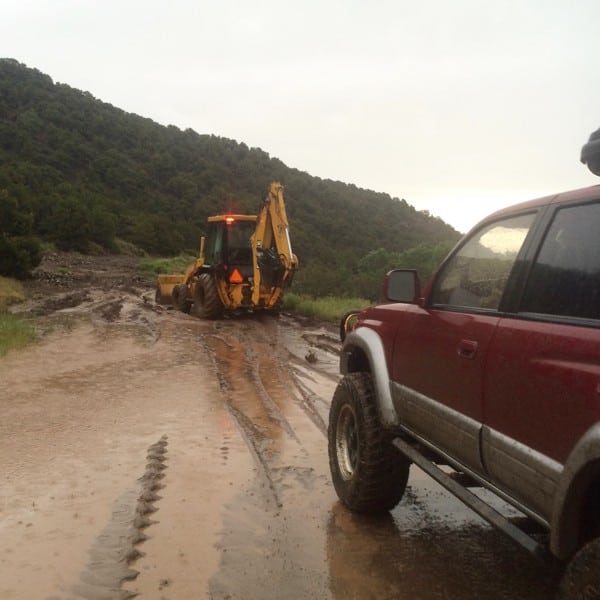There is perhaps no one else who knows Colorado’s 58 14,000-foot-plus peaks (14ers, as they are called) better than Andrew Hamilton. He started climbing them at age 11. He’s helped his two oldest children summit them all, including his oldest son twice. He’s climbed them all sequentially in multi-day, successful record attempts three times, in 1999, 2003, and 2015. In 2014, he failed at a fourth sequential multi-day record attempt very near to the end of the effort. He’s twice run the Nolan’s 14 line, a series of 14 peaks in Colorado’s Sawatch Range unsupported, in 2014 and 2015.
Phew.
This past summer, he set two records: the Colorado 14ers FKT at 9 days, 21 hours, and 51 minutes for those 58 peaks (previous: Ted Keizer; 2000; 10 days, 20 hours, and 26 minutes) and the Nolan’s 14 FKT at 53 hours and 39 minutes (previous: John Robinson, 2001, 54 hours and 57 minutes).
Double phew.
All this, and Andrew’s a stay-at-home dad to four kids who lives in the flat ‘burbs of Denver, Colorado with his wife, Natalie. His trail name is, appropriately, “Bad Dad.”
Triple phew.
We interviewed Andrew in the early fall, a couple weeks after he completed his second record of the summer, on the Nolan’s 14 line.
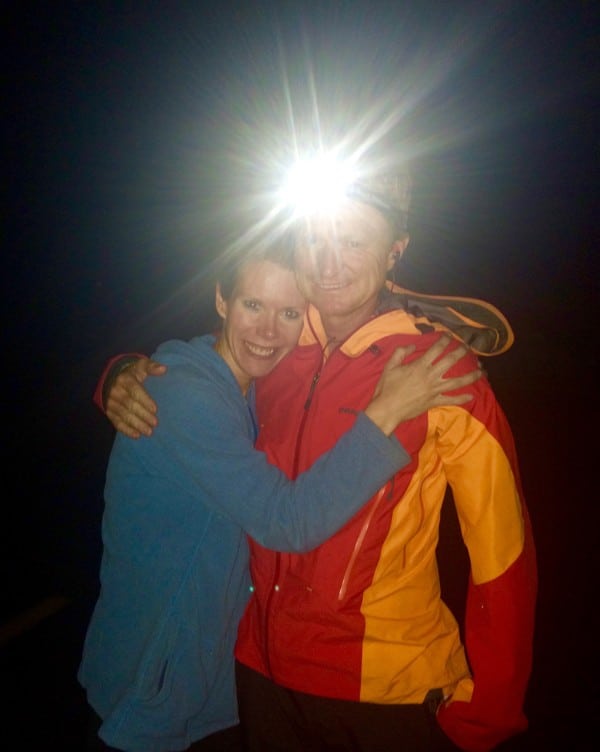
Andrew and his wife, Natalie, after his finish of the Colorado 14ers record in the summer of 2015. Photo courtesy of Natalie Hamilton.
iRunFar: You have four kids. I can’t get over that.
Andrew Hamilton: Yep.
iRunFar: You’re a stay-at-home-dad, right?
Hamilton: Yes, they keep me busy.
iRunFar: You have quite a relationship with the mountains of Colorado. Would you describe it like a marriage, an obsession, a long-term relationship?
Hamilton: Hmn, maybe you can help me here. Basically, I started doing it when I was a kid. [My mom and stepdad] lived in Cortez, Colorado. My stepdad was kind of obsessed with southwest Utah, so we were always doing trips over there. Then he got into mountain climbing, too.
I remember, it was July 4, 1986, and I was 11. He just said out of the blue, “Let’s go hike Hesperus,” which is in the La Platas by Durango[, Colorado]. We did that. It was actually, looking back, kind of an epic trip. We came down some icy snow gully. I remember slipping and falling down this snowfield. He was running behind. Anyway, he really liked it. He got hooked on hiking again. He’d done it when he was a lot younger. He’d been a hiker and climber. I would spend every summer in Cortez because my mom lived there. My dad lived in Salt Lake City which is where I lived the [rest of the year]. He was the one who really wanted to climb all the 14ers, but it was a slow process. He was a weekend warrior slowly knocking them off.
I have these memories of him taking all us kids up and trying to climb 14ers. Honestly, I didn’t really like it that much. I remember staring at his calves and being miserable and wanting to turn around. Then my sisters and my little brother–he’s a good climber now, too–he was only three at the time we started.
I went off to college at CU [University of Colorado Boulder]. I was a raft guide in my summers, so I hiked 14ers a little bit here and there. Then I got more serious about it. My last year of college, my little brother and I took this trip to go finish them off. I had 18 left and he had 22. We spent a few weeks together, and we finished them off. That was in 1998. It was the next year I went for the record the first time.
iRunFar: You went straight after it.

Andrew on Windom Peak on Day 1 of his Colorado 14ers record attempt. Photo courtesy of Andrew Hamilton.
Hamilton: Yeah, it was the next year. I was still pretty young, age 24 in 1999. I’d done all the mountains once, but I was so ridiculously underprepared. I’d just finished climbing them the year before, but I’d only done 20 of them. Most of them I’d done when I was way younger, like when I was 12 and 13, so I had really no recollection of it. The first week it was snowing every day, so I was always lost. It was just ridiculous. At that point, the record was still “soft”—I guess that’s the word people use for records that have a lot of room to go down. It was still soft in the sense that the guys who were setting it at that point were super-fast runners, but then they would spend the whole night sleeping. They’d get a full night’s sleep before they’d go off and do the next set of peaks. They’d really crush them, boom, boom, in times I can’t even dream about now, but then obviously they have to recover more. They didn’t think to go all night.
I did that record and I sort of moved on and was doing adventure racing. A couple years later I did the self-powered 14ers record where I rode my bike between them all. Then I was kind of done with 14ers. I did adventure racing.
Then we had the kids. It really wasn’t until 2008 until I randomly said, “Hey, let’s take Calvin up a 14er.” He was four. Our second kid was one. Calvin did great. The trick was we planted a jewel up on top of the mountain. He was obsessed with jewels. In fact, one time I went to Moab[, Utah] and stopped at that rock shop there. I got this raptor claw and a red jewel. I gave him this whole story about how I went into this cave and got the red jewel and the raptor tried to get me and left this scratch on my back. I showed him the claw. He was just in awe at four years old. Anyway, we planted a jewel for him to find on top of Mount Antero. Even though he hiked 16 miles that day and 5,000 feet of elevation—it took us 17 hours…
iRunFar: Seventeen hours?
Hamilton: With him, he’d never travel more than a mile per hour.
iRunFar: He kept going all that time?
Hamilton: He did. I’ve got a picture of him just collapsing, trying to get a few minutes of a nap in on a rock on the way down. He was hurting. I swear it was the next day and he’d completely forgotten the pain. All he remembered was the jewel. I had never really intended to take him up all the 14ers because I remembered my past of being miserable following my stepdad. I didn’t want to impose this on him, but he really liked it. He kept wanting to go up more and more. We did 10 that first year. That was 2008 when we started. It took four years until we finished them off.
Then his little brother, Axel, was growing up, so then we started with him. I was hiking with the kids, and that was my only sport. I’d quit adventure racing in 2007 because with all the kids it was too hard to race and stay in shape. The only exercise I would do is hike 14ers in the summer with the kids.

Andrew’s son, Axel, on Capitol Peak’s Knife Edge at age six in 2013 on his way to climbing all of Colorado’s 58 14ers before turning seven. Photo: Andrew Hamilton
It wasn’t until 2012 when this guy, John “Homie” Prater, went for the 14er record. He was the first guy in my 12 years who had gone for it. The guy who broke it after me in 2000, Ted Keizer, he took so much time off of it because he was the first to really conceive of going from start to finish in one big route. He didn’t think of it in terms of days. He’d just go all day, all night, and all day—he took three days off the record. People thought Ted’s record would never fall. No one was every really interested. Then it was really cool to see Homie go for the record in 2012. He was on pace at first to break it, and then he fell behind and got injured. It was super exciting. People were following along online. He really inspired me to start thinking about that record again.
To make a long story short, I’m not sure exactly how to answer your question, but all my life I’ve been around the 14ers. Honestly, I don’t have much experience outside of Colorado mountains. We took the kids and climbed Kilimanjaro last year. Other than that, I did one trip to South America when I was 20 and climbed a volcano there. I’ve really hiked very little outside of the state and outside of the 14ers. I’ve done a handful of 13ers. It’s kind of weird. I haven’t branched out too much.
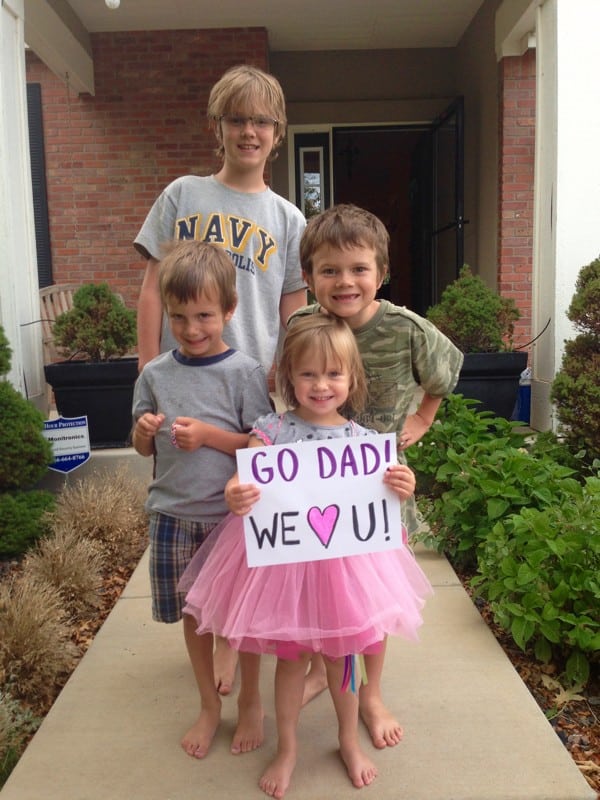
Andrew’s four children (left to right) Luke, Calvin, Birdie, and Axel cheer their dad on during his 14ers record attempt this summer. Photo: Annabel Foery
iRunFar: That’s definitely a long-term relationship.
Hamilton: Yes, a long-term relationship.
iRunFar: With a couple break-ups and make-ups.
Hamilton: Yeah, right, definitely—an on-and-off relationship.
iRunFar: Your relationship with them is definitely on right now. What I find almost miraculous is that you are a father to four. All of your kids are relatively young. You’re a stay-at-home-dad and your wife works a demanding job outside of your home. I think there are a lot of parents out there who wonder how one, you manage to train, and two, you manage to set aside these blocks of time for these record efforts. The whole family must be really supportive.
Hamilton: There were a couple years where my wife was in medical school and I was working my job as a computer programmer and taking care of the kids and she was always gone. I remember for an entire year I probably averaged three hours of sleep. We were always joking it was great sleep-deprivation training.
The funny thing is that I don’t feel like I’m a real athlete because I can’t train very much. Like you’re saying, with all the kids, the mornings are heck trying to get them off to school. You get them to school and I swear, you come home and get the house picked up a little bit and it’s time to pick them up again. It drives me crazy. Then you chauffeur them all around to all their activities after school.
My most effective training comes in late spring, like April and May, and early September. The way I do that is it’s three miles to get to their school. I’ll put the little ones in the jogger and the big ones have to ride their bikes—so three miles to school, and then I run back three miles. I get them in the afternoon and back running, too. It’s all flat and on a road in Denver, but it’s 12 miles. That whips me into pretty good shape. I don’t lose that much time out of my day when I get my workout in like that. It’s a little more time to run, but it’s not that much longer, whereas if I came back home after dropping them off and did a 12-mile run, it would be noon by the time I was all done. I would lose my whole day to do the workout. That’s basically my most effective training.
Then the other thing I’ve been doing is—have you seen that Insanity workout? Yeah, I do Insanity. My wife got me Insanity for my birthday probably five years ago. The first time I went through it, I was so depressed because I never look quite as good as the people on TV doing it. The first time I did that, I was like, “Holy crap, if I’m ever going to go for the 14er record again, I’m going to do Insanity right before I do it.” When you just jog all the time, you develop all these little injuries. Your hamstrings get tight. Your hip flexors are sore. Your knees are aching. With Insanity, you’re jumping around a lot. You’re doing plyometrics workouts. You’re always doing high intensity. When I’m jogging, I’m a slow jogger, like 10-minute miles. Insanity is full intensity. You’re working the hip flexors and all the tendons and all the joints. They all get strengthened. That works wonders for me. It used to be when I’d try to hike fast, my hip flexors would get really sore. Now I don’t have hip-flexor issues.
I’ll tell you, Insanity is a thing I dread. I’m perfectly happy to go out and do my run to the school and back. Man, I don’t want to go downstairs and do Insanity because it is just pain. If you’re just doing Insanity, it’s only like a 30 to 45 minutes per workout. It’s really not that big of a time commitment. Then it helps having a wife who makes me go downstairs and do my workout. Even though I’m crying and I don’t want to do it, she’s always making me go do it. That’s helpful.
In the old days when we didn’t have kids, I could go on four- to five-hour bike rides every day. I could go for long runs in the mountains. I can’t do that anymore. Fortunately I found this method of training that does work for me.
Then the other secret for me really is, I can’t do short events because I’m just too slow. People run circles around me if we’re just hiking up a mountain. What I can do is I can try to eliminate sleep because that’s what I’m better at, going without sleep. Nolan’s, basically, I do 60 hours, there was no plan for any sleep whatsoever. I didn’t pack a sleeping bad. I didn’t really pack any warm stuff except for my puffy jacket. That’s why doing it unsupported I’m able to beat the supported guys. They’re definitely moving faster, but if I were to have support, I’d probably come running down and stop at the car and get some nice, warm soup and sit there for awhile, and before you know it, 45 to 60 minutes is gone. It’s just hard to make that up out there on the trail. You’re going to have to work that much harder, and then you’re going to be that much more beat. You can just try to go straight through and skip all those stops. It can be a way to save time. It works for me anyway.
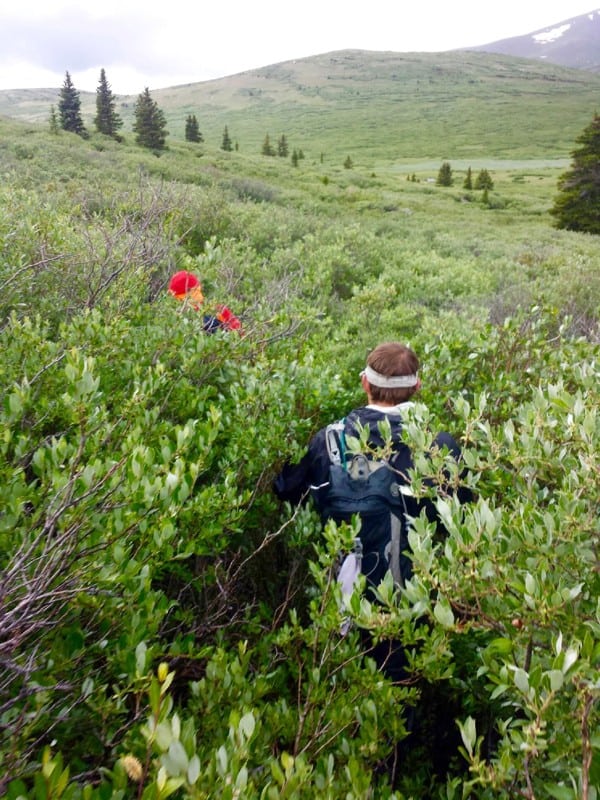
Andrew and Stefan Griebel mucking through willows on Mount Bierstadt during 14ers record attempt. Photo: James Sims
iRunFar: I want to ask you more generally about the way you move in your record outings. In following your efforts on the satellite tracker for Nolan’s and for your 14ers attempts, it’s hard to tell if there’s any running. On the downhills, are you doing any trotting?
Hamilton: It’s really funny, so in my mind, on the downhills…
iRunFar: “In my mind, I’m going really fast!”
Hamilton: Exactly! On the 14er record, after I was about halfway through, people were showing up for every peak. Actually, one guy had a funny analogy. It was like Forrest Gump where he’s running across the country and there’s this pack of people behind him. That was what it felt like. Because nobody can help, they can’t offer me advice on where to go if I’m lost in a fog, so they’re just sort of sitting back there.
I’d try to jog, especially the downhills. What would be funny is when you look over your shoulder and they’re just walking along at the same speed. I’d be like, “What’s the point?” On the 14er record, there was very little jogging, and if there was, it was sort of like a shuffling jog. It was like a four- or five-miles-per-hour jog. If you’re hiking and getting three miles per hour, that’s pretty fast hiking. If you’re ever seeing me going four or five miles per hour, that’s where I’m jogging. It’s a slow jog.
On Nolan’s, I had some spots where I was running hard, like that last day especially when I saw I was in range of the record. I ran hard down Elbert. It probably doesn’t look so fast [on the satellite tracker] because it’s pretty rough terrain. It’s a steep ridge with big boulders and lots of scree. I’m probably not going very fast, but it feels like running.
iRunFar: It’s the running motion.
Hamilton: Exactly. In general, I’m a one-speed guy. I don’t think of these things in terms of mileage; I think in terms of elevation. If you’re doing 14ers, I’m always thinking, Okay, if it’s 4,000 feet to the top, that’s probably going to take me two-and-a-half hours because I’m probably going to be going 1,700 to 1,800 feet per hour.
I’ll have my time estimate, and then I’m always trying to beat my expected splits, just trying to take 10 minutes off this one and 15 minutes off the next one. Slowly it adds up over the course of the whole thing.
iRunFar: It seems that your 14ers record crew was remarkable. How indispensable were all those people who were crewing you?
Hamilton: There are all these different elements. Imagine, so your fitness is obviously a big part, there are logistics, there’s route knowledge, and then there are the mental aspects like sleep deprivation and just making good decisions when you’re tired. If you think about a square and each of these elements are a side of the square and each are important to break the record. You can skip on one of them, but you’re really going to have to make up for it somewhere else. If you’re a super-fit guy, you can go really fast, you might be able to skip on your logistics a little bit. Or maybe you sleep a little more because maybe mentally you’re going to be a little more beat up, so maybe you won’t do as well in the night or something.
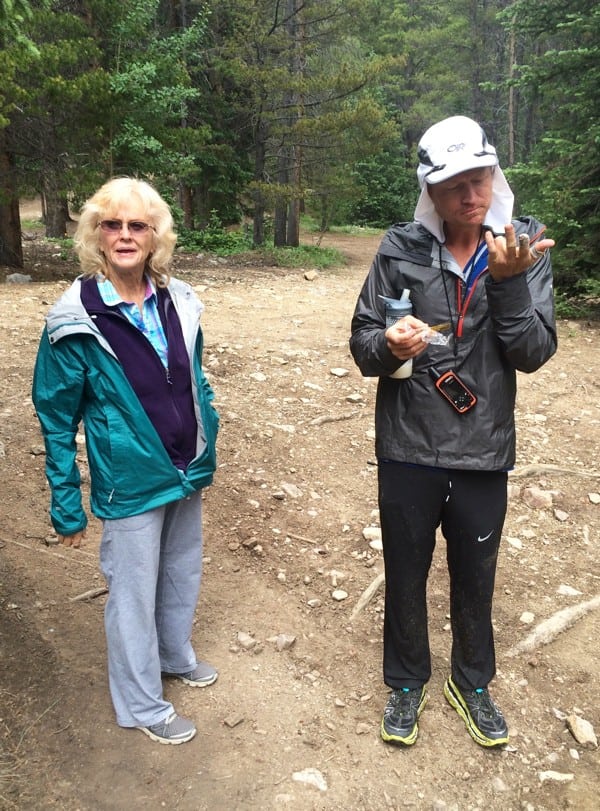
Andrew with his mom, Brenda, who was crewing, on Day 7 of his 14ers attempt. Andrew is inspecting his hands, which are raw from scrambling. Photo: Laura Hamilton
For me, though, because I’m not super fit, it was all about the crew and not making logistical mistakes. In fact, there was a really cool graph that someone came up with. It compared some of the previous record attempts and it broke it down to transitional hours and actual hiking hours. What was interesting was that for me and Teddy, the previous record holder, we actually had the same amount of hours out on the trail. Where we really beat him was in that transition time. We dropped 23 hours from his crew’s time.
A lot of that was luck, too. He had a better plan, but he really got screwed by snow at one point. He was in the Elks, and he basically did Pyramid by itself, and then he didn’t want to go onto the Bells in the snow which is probably a good call. So his crew drove him over the Sawatch and later they had to drive back. There’s a whole bunch of extra driving time in there. My philosophy going in was no matter what the weather was, I was never going to turn back and go somewhere else because I didn’t want to give up that time. I figured if I have to hike slower or whatever, it’s still going to be faster than driving around trying to get better weather.
The other advantage we had was that I failed at my record attempt last year, but I was pretty close. So I had really good estimated times for my crew. They had a spreadsheet of when I was expected to be in. They had eight days worth of accurate estimates from the previous year.
As far as the crew was concerned, they basically knew where to go. I was pretty much coming in right on schedule, maybe a little bit ahead and later a little behind.
Then the key was, just by luck at one of these 14er happy hours, we met this guy, Kyle Knutson, who has this awesome vehicle, and he was willing to come and drive me around. He was amazing. I mean, we were literally caught behind a mudslide. We were up on Lindsey and the rain and wind were so intense, I got to the trailhead and my crew wasn’t there. I was a little annoyed when they came in 10 minutes late and they told me, “Oh, we barely got through this mud.” So we’re going down and in the time that had passed since they were in this area to come get me, this mudslide had come down. We’re literally stuck up there. Kyle was just so calm the whole time, “Oh, it doesn’t matter if I get stuck in the mud. I’ll get my winch out and just connect to that tree down there. It’s not a big deal.” He was amazing at staying calm. There was nothing that could faze him. At one point a rod broke off under his car, so he just drove up onto the side and repaired it. I would have been helpless.
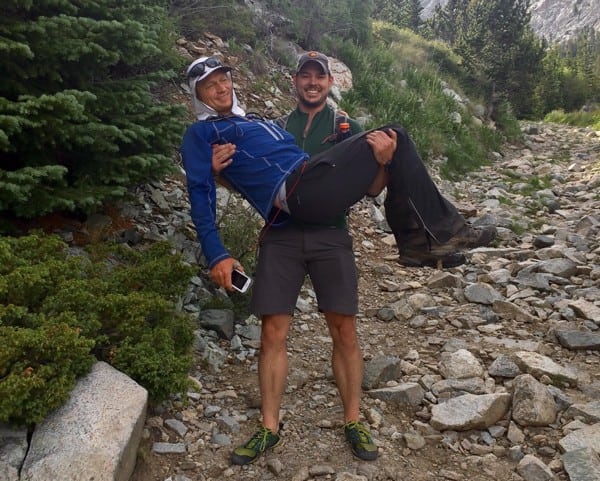
Crew member Kyle Knutson jokingly carries Andrew below the 3,000-foot line on a 14er on Day 3 of his 14ers record outing. Photo: Natalie Hamilton
We also had my friend, Andrea Sansone, who was there in the van. I’d come in and she’d retape my legs and massage them. That was key. I’d just go to sleep, and they’d stuff a bunch of food in me. I had my wife and my sisters driving vehicles around. Yeah, it was a big deal to have a big enough crew that we could absorb some of these problems like the mudslide. Basically with the mudslide, I did end up having to just leave the cars there. There was actually a guy up there with a digger trying to dig the road out to get us out of there. I ended up jogging down the road a couple miles and getting into one of my vehicles that wasn’t trapped by the mudslide. If we’d only had the one vehicle, that would have potentially been a big problem there.

Andrew eating after finishing the Crestones on Day 4 of his 14ers record attempt while crew member Andrea works on his feet. Photo courtesy of Andrea Sansone.
My sister, who has been part of many of my record attempts, she just sort of gets the whole logistics thing. She sees the big picture. In fact, she was telling everyone, “Don’t go up the road right now. Don’t go up the road,” because she had a bad feeling about it. I guess she remembered from the past how bad that road was.
I even had two of my kids there. They were having to deal with the kids, too. I wanted to have them there, but on the other hand, I know they’re in the way a lot and they’re not super helpful. They had to not only deal with me, but they’ve got the kids and stuff. It’s everything, having the crew.
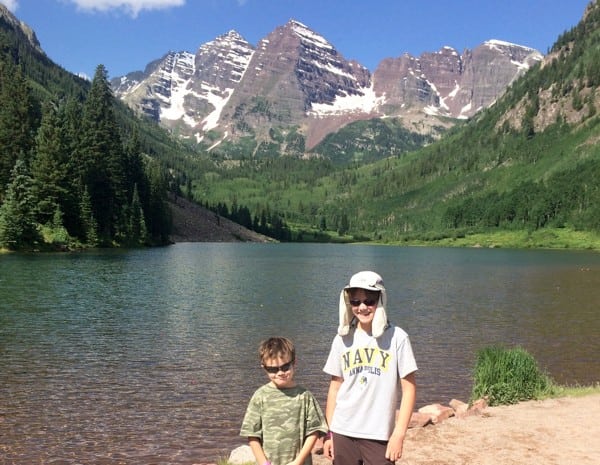
Axel (left) and Calvin wait for their dad Andrew at Maroon Lake during Andrew’s 14ers record effort. Photo: Natalie Hamilton
Oh, and the other things they did, in that record you’ve got this 3,000-foot rule. So within 3,000 [vertical] feet of the summit, you can’t have any help whatsoever. Before you get to that point, if I had enough people, they could carry me, theoretically. People would carry my pack on these trails to 11,000 feet. I remember on Longs, this guy who lived in Boulder and had the speed-ascent record on Longs, he actually got in front and showed the way up his speed route, not on the main trail, all the way up to 11,000 feet. I could never duplicate that route. It was like, jump over a log, duck under a tree, jump over a stream and up this trail. Crew was a big deal.
iRunFar: I want to ask you about suffering. You must suffer. What is suffering like for you?
Hamilton: First of all, I’ve done adventure racing for a long time. I really feel like, for Nolan’s, too, that adventure racers are well-suited for this stuff, maybe better than ultrarunners. Ultrarunners are definitely fast, but there is this whole sleep-deprivation aspect to something when you’re going 60 hours. Someone like Danelle Ballengee, she was spectacular [at things like this.] She did the [women’s] 14ers record, and that’s an amazing story. The amount of weather that she put up with was unbelievable and to still have that fast time. There is an aspect to just having this experience.
I’ve been in a couple of these 10-day adventure races where you’re going a long time. I blew a couple races for my team because I couldn’t deal with sleep deprivation. I was the rookie on the team. I remember back then believing that it was smarter to sleep for three or four hours because then you’d wake up and be that much stronger. For me that kind of worked a little bit because I would be a lot faster when I’d had the sleep and less prone to making a huge navigational error. I remember some teams that would try to go all night, almost all teams, actually, would make some huge error, so they’d be up all night for nothing. So there’s definitely some stuff I believe about that.
I remember being with this team where I just blew the race. They didn’t believe in any sleep whatsoever. If you were really hurting, maybe you’d get five minutes. I just was sort of getting dragged along with my little brother. He was on this team, too. It was the two of us with these two experienced people. I remember not even really being coherent and trying to follow the light off in the distance of my two teammates who were doing all the navigation and stuff. I saw that they could do it. I knew it was possible. Then I started experiencing that where you’d just get that five minutes and then you’d wake up and pop out of it. I believe you can do it without sleep.
In adventure races, it’s a little tougher because you’re usually on some course you don’t know. You’re having to rely on your navigational skills with your map and compass. On the 14ers, gosh, I’ve done them all at least 10 times except for Culebra. I know the routes well. I’m not having to do that navigation so much in the dark. It’s really more about, can I stay awake? Where I feel like I’m suffering is just when I get really tired. Usually when that happens, you’re going fine in the daylight and then it turns dark. It just gets incredibly difficult to stay awake. You’re nodding off. You start hallucinating.
Like in Nolan’s, the first thing I did was listen to the audio book of The Martian. But then, after that I kept seeing Martian landers and astronauts. You start hallucinating all this stuff, the suffering of just trying to stay awake.
For me, my number-one defense against that is 5-Hour Energy. I try to hold off as long as possible before using those because they don’t actually work for five hours. They will give me a little boost.
I just never know how I’m going to handle [sleep deprivation]. For example, before Nolan’s, I tried to do this Elks Traverse with my friend Charlie, which is where you link up the Elks Range. That’s a much shorter adventure. We were expecting about 34 hours for us. We started at 4 p.m. and at 9 p.m. it had turned dark and I was already not able to stay awake. I had to down two 5-Hour Energies on the first night which was super demoralizing. Then we were hurting so bad in the morning, we just gave up.
I was really afraid going into Nolan’s that my body would act like that again. You just don’t know. For me, that’s the suffering. I go at a slow-enough pace, I can usually keep it going all day without too much trouble unless I’m injured. But really, it’s just fighting the sleep monsters and trying to stay awake. That’s when I suffer.
iRunFar: The Nolan’s line and your 14ers record, they’re two totally different animals. You’re traveling off trail for much more of Nolan’s. You have to descend as far down as you need to go before you ascend the next one. In your case, you didn’t interact with any crew. You had the imposition of the shadow of last year, of not reaching the final trailhead in under 60 hours, on your shoulders. What made you want to go back and do Nolan’s this fall?
Hamilton: Well, there were a couple things. The number-one thing was that I felt like I had really blown the first night last year. My knees were killing me. My legs were feeling like toast after Princeton. Princeton, it’s the mountain you have circled when you’re going for Nolan’s. On the 14er record, Princeton isn’t so bad. You can take this road up and you get all the way up to 11,000 feet and then there’s a trail all the way. But on the Nolan’s route, it’s just a beast on both sides. Many times, usually going the opposite direction as me—people going north to south—they’ll be well ahead of record pace, and they hit Princeton their second night and it just crushes them.
Last year on Princeton, it killed me. My legs were shot. Then going from Princeton to Yale, it’s endless. I remember just screaming at the trail like at the top of my lungs. I was like, “WHAT THE F*%$!?” Pardon my French. It would never end. I was so frustrated. Then you get to the road where you know there are miles left just to get to the trailhead for Yale. You feel pretty desperate. Then I did Yale, which was slow. The route I took off of Yale, I was kind of copying a route other people had done. It’s super steep with all these logs. You’re climbing under logs and crawling over logs and you’re squeezing through logs and it’s bloody steep. It took me two-and-a-half hours to descend. I felt like I had all this time in this one area from Princeton to Yale to Columbia. I thought there was at least three hours I could take off my time from last year.
Then I knew the navigation error I made last year at the end cost me an hour. So I knew there was another hour there.
That meant I was looking at 56 hours right there [for a finishing time]. I actually thought, Man, if I have a great run right there, I know I’ll get an hour off at the end. I just have to make up another hour somewhere. I could actually take a shot at the actual record, not just the unsupported record, but the actual record. The funny thing was, this year when I did it, I only gained three minutes on that section. I didn’t make up any time. At that point I remember I sent a text to my wife, “Dang, I didn’t make up any time,” so I didn’t think I was going to set the record, but I still felt unless something really crazy happened, I’d still break 60 hours.
That was the other goal was to fully come in under 60 hours this time. That was the goal, too. The last time, I didn’t actually get under 60 hours back to the last trailhead. Normally I wouldn’t have cared, but there was all this debate this year about what constituted an actual Nolan’s run, or where was the exact endpoint for the 60-hour cutoff? I always sort of felt a little exempted from that discussion because I went unsupported last year. Kind of like, well, duh, who cares? But then, people were literally saying online that I can’t count myself as a Nolan’s finisher because I didn’t hit this 60-hour timeline trailhead to trailhead. I’m like, seriously, you would tell a guy to his face who just did it unsupported that?
Then I started thinking about the whole 60-hour time limit. I get it for ultrarunning. Actually, that’s the best part of the Leadville 100 is watching the people try to get in under the time limit. I love that part of that race. But for Nolan’s, a lot of people are saying, “Hey, I’m going to go do Nolan’s, but we’re going to take four days. We’re not going to try to get in under 60 hours. I just felt it was kind of weird to say they haven’t done Nolan’s 14. For me, it was about the course, Nolan’s 14. It was just annoying. Some people would say, “Oh, well only the people who have finished should be able to vote.” So, there was a little bit of this competitive, annoyed Andrew that just wanted to go crush it. There was a little bit of that for sure.
iRunFar: In part a statement to the people who doubted you?
Hamilton: Yeah, there was a little bit of that, but that wasn’t the only driving force.
The other thing that’s funny, too, is actually, I almost didn’t even do it because my wife, who works all the time, had two weeks off. She just finished her fellowship with being a doctor, so she was gone all last year. She’s gone most of the time. She had two weeks off, and the first three days I was off doing another Elks trip in addition to the one I’d failed before. I felt kind of guilty because I know she’d wanted to go on some hikes and stuff. I came back and I was like, “Listen, I don’t need to do Nolan’s this year. I really don’t need to do it. Let’s just us go into the mountains.”
Then a couple days later, she’s looking at the weather, and she sees that there’s this good-weather window. Wednesday of that next week was going to be bad weather. She’s like, “You should just go do Nolan’s, but you have to go tomorrow.” So, basically, I was like, “Okay.” So I packed up and went the next day. It was kind of this last-minute thing. I almost didn’t even do it, but I’d been thinking about it. All year long, I’d been thinking if I did have a chance, I’d go do Nolan’s. I actually don’t even think of September. Most of the Nolan’s attempts are in September. There’s usually a bunch of them on Labor Day. I actually don’t even think that’s the best time to do it. For me, that’s why I always do the big 14er record, I go for the end of June. This year it kind of bit me because it was lousy weather. I’d love to get some of those big descents on the snow. If you could just nail it so there was just enough snow to fill those couloirs, but not enough snow so you have to wear snowshoes, I feel like late June you’d have perfect weather. I’m surprised not too many people try Nolan’s then, although someone explained to me that typical ultrarunners like to use the summer to get in shape. So, maybe that’s what people are doing is training, and then they’re in their best condition at the end of summer.
iRunFar: I also would suspect that some people who are trying Nolan’s don’t come from a mountaineering background. They may not have the snow-travel experience that would make them comfortable on big, snowy descents.
Hamilton: That’s a good point, yeah, especially because you are off normal routes.
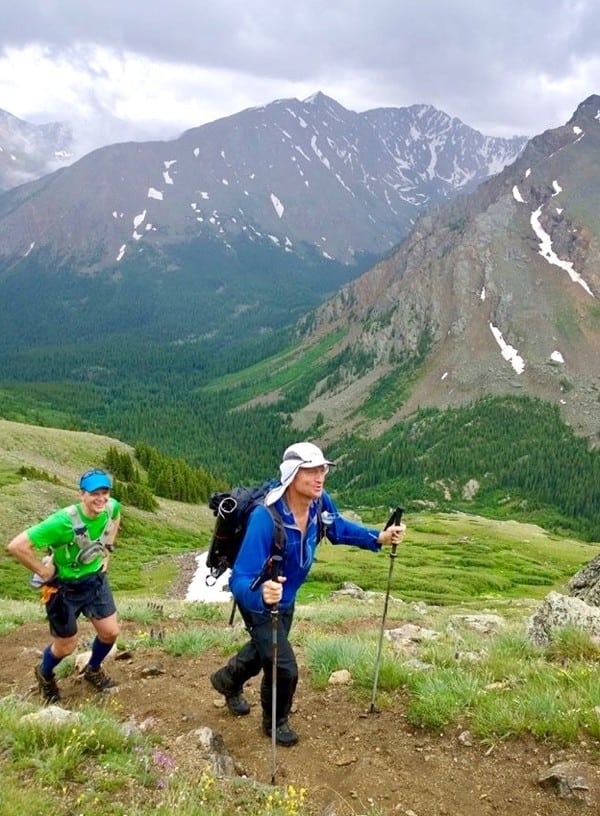
Ascending Mount Massive with John ‘Homie’ Prater near the end of Andrew’s successful 14ers speed-record effort. Photo: Charlie Nuttleman
iRunFar: My last question for you. You’ve had a huge summer. It feels from the outside looking in that you’ve had retribution on things that didn’t go quite your way last summer. You’ve bettered the 14ers record by pressing on a day, after having to stop close to the end last year for injury. You’ve set the FKT for Nolan’s and it went down by a ton. Are you sated now? Are you ready to put away the 14ers for awhile? Are you just going to climb the 14ers with your kids now? What will you do?
Hamilton: I need something. I go through these big cycles. I tend to gain a lot of weight in the off-season, and in spring I start trying to get in shape again. Last year it was great. From the moment I failed the 14er record, I was planning on going back because I was so close. I knew I could do it. It was just this freak compartment-syndrome thing. I’d gotten this blow on day one that kept swelling and swelling and swelling. Knowing that I was going to go back kept me motivated.
I do need to find something else to keep me motivated. I do have lots of ideas floating around in my head, but nothing for sure right now. Nolan’s, there’s still this north-to-south direction. I had actually wanted to add on the last Sawatch peak called Holy Cross. This year, I had stopped at the finish line [before starting the attempt] and stashed in a bear canister, a sleeping bag and a pad and some supplies. I was thinking that if I show up there—I want to sleep for awhile—but then, I could call it self-supported because once I take on any gear, I’m not unsupported anymore. Once I take on any food from a stash, then I’m self-supported. I could get some sleep, wake up, and just go onto Holy Cross which is another 35 miles. There were a couple people there, and my blisters were bad enough, so I forgot that. Still, I’m kind of sad that I didn’t get Holy Cross on there. I would like to be the first person to link that one on there.
Then I’ve never done… I don’t really like the north-to-south [Nolan’s] line for me. The timing just doesn’t work out on where I end up. I like to really fine tune my timing so I pick and choose where I am in the light and dark. There are certain spots I don’t want to be in the dark. Going north-to-south, I really don’t like where I end up with the timing.
There was this guy, David Ruttum, and he almost set the record earlier in September. He was going north-to-south. It was weird, though. He got lost near the end, and it cost him a couple hours, and he missed the record by a couple hours, so it was really close. He started at 9 p.m. The good news was that going north-to-south, he actually got all of Princeton in the light, so that was great. It didn’t destroy him like it does everyone else. But then he made a mistake on the next section which usually you would be doing in the light, but it hit him in the dark. He did three nights and two days basically. Usually you start so you get three days and two nights, so really what he did was pretty spectacular. The fact he did three nights and two days and almost broke the record—that’s something.
For me, I don’t want to do three nights and two days. The nights hurt. I haven’t figured out exactly how to time that run. Some of the spots, for example, where I come off of Yale and start that bushwacking, I’m not sure exactly where to start that bushwacking going the other direction. I’ve definitely got some scouting work to do in there if I wanted to perfect my north-to-south line. So that would be a possibility.
Other things are, I just got my five and three year olds up three mountains this year. I’ll tell ya’, taking the kids up is way harder than doing these records. It’s so difficult. They’ve got these roller coasters of emotions. They’re super happy, and then they’re super sad. They’re super happy, and they’re super sad. My three year-old, Birdie, she was unbelievable. She hiked all the way up Massive by herself. That was her first one. But then she completely fell asleep, and you couldn’t rouse her. I carried her down all the way in my arms. I’ve got a huge pack on with gear for all four kids. My back was just killing me. I was dying at the end. Mount Massive, it took us 12 hours to do eight miles. It’s super, super hard. It’s a big deal starting to hike with the five and the three year old, too, right now.
The other idea is doing some 13ers or maybe going to California and doing those 14ers.
The other thing, too, is I don’t know how I’ll react. I know there are some good guys gearing up to go for the 14er record. I don’t know how I’ll react if someone comes along and just takes a little bit of time off. I might think about that again, too. There’s this guy, Brett Maune, he’s tried a few times but has failed for various reasons, but he’s really fast. Where he’s weak is putting together a good team. Physically, he blows me away. I remember his first two days are hours and hours faster than my first two days. If someone came in and just put it out of reach, that would almost be good news. I wouldn’t have to think about it anymore. But if someone beat me by an hour or two, then I’m going to be thinking back to the mudslide that got in my way. I’ll be thinking back to all the rain at the end. Longs took me a couple hours longer than it should have just because it was all fogged in and stuff. Then I might actually have to start thinking about the record again.

Andrew and supporters on Andrew’s last peak, a foggy Longs Peak, on the last day of his Colorado 14ers record. Photo: James Sims
That’s the one I really care about. The Nolan’s one, to me, is just a subset of the 14ers. What I love about the bigger 14er record, is there’s so much more into it than just going in and suffering for 60 hours. That’s kind of how I see Nolan’s. You just go suffer for 60 hours versus with the other one you’re trying to organize vehicles and people and these different routes. It’s much more of a complicated process, which I enjoy.
iRunFar: Well, congratulations to you. You had a huge summer. You’ve had a huge career in the mountains of Colorado, but this summer alone is pretty amazing. I hope you let yourself bask in the glow a little bit.
Hamilton: Thank you. Oh, I know. It’s funny. You come back and it’s back to real life again. The kids are screaming and school starts up, and yeah. I wish there was more time to think about it, but there’s not, really. Thanks a lot.
